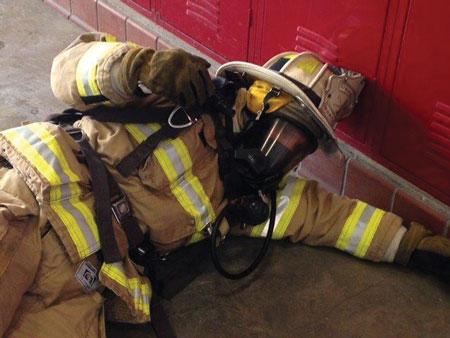
The last words anyone on the fireground wants to hear are, “Mayday! Mayday! Mayday!” This is when everything is set in motion for you to go in and rescue your fellow firefighter. Some Mayday classes that focus on getting down firefighters out of buildings include drills on how to pull them out of basements and windows, carry them down ladders, and so on. When self-rescuing, these classes cover ladder bails as well as profiling to escape through narrow openings or through a wall. However, few Mayday programs spend as much time as they should on the down firefighter. The programs teach a few techniques such as air conservation, body positioning, stress management techniques, and so on; these key factors are going to help keep that firefighter alive. A proactive rapid intervention team (RIT) and a quality accountability system will obviously factor into this situation, but if those two things are ineffective, the down firefighter could have a fighting chance if he is trained properly and he continues to practice the skills that will keep him alive.
Over the Radio
Think about all the Mayday traffic you have listened to over the years. How often have you heard someone call out a proper ASLIP (Air, Situation, Location, Intent, and Par) or LUNAR (Location, Unit, Name, Assignment/Air supply, and Resources)? In a perfect world, every firefighter who has been in a bad spot will rattle these off with ease. Even with training and repetition, we fail to hear these acronyms used as much as we would like. The firefighter placed in this extremely stressful situation will have his ability to think straight, hear radio traffic, and conserve air decreased severely. As the incident commander (IC), it is unrealistic to expect this firefighter to be able to recall every bit of information mandated by company policy. He will ultimately relay information to the IC regardless of what policy is in place or what he has learned in training. If you are the firefighter in trouble, you only need to pass along the information needed to get you out of the situation. For example, if I fall down a set of stairs and no one is around me, there is no fire chasing me down, and I have a good air supply, I may be able to calmly give a full ASLIP or LUNAR. If I fall through a basement, get trapped at the end of a hallway by fire, or become lost in a building and cannot find my way out, my panic level will increase. In those circumstances, it is unlikely that I could pass along a full Mayday report.
Managing Your Air and Stress
What happened to make you call the Mayday? And, where do you think you are in the building? These two basic questions will inform the IC of where to deploy resources and what equipment those resources may need if the RIT is deployed. A down firefighter using a long acronym may prove useless in certain situations; relaying all of the information dictated by this policy will cause him to consume more air, thus decreasing his chances of survival.
 |
| (1) This down firefighter lies down with the PASS device up to maximize the sound of the device and provide audible direction to search teams. (Photos by author.) |
Once the RIT is activated and they are on their way, there are several things you can do to preserve yourself. First, conserve your air. You will hear a large amount of radio traffic regarding the RIT’s search. As a result, you will talk more, and the more you talk, the more air you will use. Pass along only pertinent information that will help you get out of your predicament. United States Army Lieutenant Colonel David Grossman used the term “tactical breathing” in his book On Combat to describe a type of controlled breathing that puts you in a relaxed state. This can come with practice and can be used in high-stress situations.
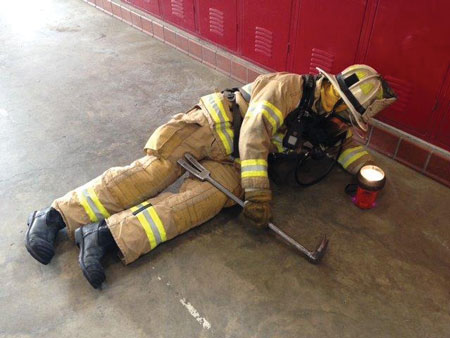 |
| (2) The firefighter has positioned his body perpendicular to the wall to better allow search crews to find him. He shines his light to the ceiling in flashing mode and uses his leg to support the tool while striking it on the ground. Using your leg as a fulcrum allows you to save upper body strength by not having to support the full weight of the tool. Remember, if you know the location of the doorway, point your flashlight in that direction to alert incoming crews. |
Now, you may ask: A relaxed state? In a Mayday situation? Although I may not necessarily do well with it, it is something we must think about and practice. Sometimes, by controlling your breathing, you can manage stress and fight off things such as auditory exclusion and a decrease in your cognitive abilities. Learn ways to manage stress and incorporate them into your training.
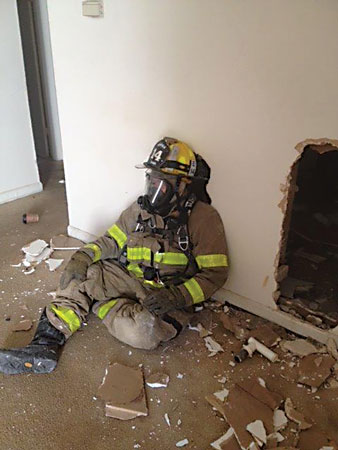 |
| (3, 4) Here, the firefighter has breached the wall and begins to “swim” backward to make entry into an adjacent compartment. Keep in mind that you should create a hole big enough to get you through while limiting the space for heat and smoke to travel. |
It may be difficult to create a realistic environment for the down firefighter, but you may have opportunities. At your next fire, think about controlling your breathing. While working in a hallway, think about your surroundings-the heat, the sounds, your stress level, and how much energy you are expending. When searching through hot smoke in zero visibility, focus on your senses-what you feel and what you hear. Listen to the sound of air coming in and out of your face piece (in … out, in … out), that nice, smooth pattern of breathing control. Any opportunity you get to practice managing stress in a stressful environment will only help you if you find yourself in that most stressful situation.
Taking Action
Now that you have controlled your breathing and radioed to command what he needs to know, it’s time to take some actions (if possible) to increase your chances of being rescued. First, activate your personal alert safety system (PASS); this will give crews an auditory advantage while searching for you. Place yourself in a position where your PASS is not covered up and emits the best signals it can (photo 1). If you are not injured and can crawl, crawl to the closest wall and position yourself in a way that crews can find you as they search. For instance, position yourself with your head against the wall, feet straight out, light on and pointed up or toward the direction of the door (if you know where the door is), and PASS device up (photo 2). Most fire service lights are now LED lights that blink; if you have this option, place the light in “blinking” mode. A steady light is not as likely to catch a passing firefighter’s attention as a flashing one. If you have maintained control of your tool, strike it against the ground to transmit a loud sound. Using your leg as a fulcrum to strike the tool will save some strength in your upper body, but be careful about doing this to the point where you will use too much air or energy.
Self-Rescue Tactics
The steps I just covered are applicable in a Mayday where you are unable to self-rescue and may have to stay in one spot waiting for rescue by the RIT. The last thing you are going to do is lie there and give up, especially if you have the strength and the right mindset. So, if you are able to attempt self-rescue, be cognizant of several things such as the location of the fire, where other crews are operating, and the construction type of the building you are in. These steps will direct your actions as you begin to exit the building. If you are crawling around looking for an escape route, pay attention to the types of rooms you are entering. In a dark, smoky environment, you should be able to feel the difference in flooring when you transition into certain types of rooms. For example, if you are crawling over carpet and you come across a threshold and then tile, it could mean you are in a kitchen or bathroom. The makeup of this room should give you an idea of which room you are in.
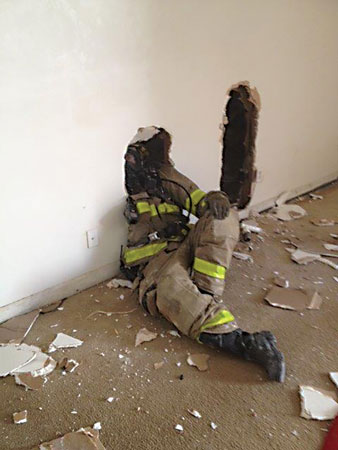 |
| (3, 4) Here, the firefighter has breached the wall and begins to “swim” backward to make entry into an adjacent compartment. Keep in mind that you should create a hole big enough to get you through while limiting the space for heat and smoke to travel. |
If you attempt to breach a wall in a bathroom, be sure that there is no alternative. Bathroom walls are filled with plumbing pipes and other conduits that could make this breach very time consuming. Not all bathrooms have windows through which you can escape. However, if you find one, it may be a small one that can be made larger with power tools. Once you are at the window, radio the RIT or IC your location; either should be able to find you from the exterior. In some houses, there is a window above the kitchen sink. If you are in the kitchen, locate the sink and check above it to see if there is a window out of which you can exit.
Bedrooms also offer a good place of refuge, especially behind a closed door. Recent National Institute of Standards and Technology studies show that cheap interior wood doors, such as bedroom doors, hold up under fire conditions for an average of five minutes; this is a long time to locate a window or breach a wall to get to another survivable area.
 |
| (5) The firefighter positions himself on his hands and knees and uses the force of his major leg muscle to break into the wall. Performing this “mule kick” not only keeps you low but is also more effective than standing up and kicking the wall only with your toe. |
Interior walls are easier to breach. However, depending on the age of the building, you may be faced with trying to get through plaster and lathe, which also may be time consuming. Use your tool to get through the wall, profile yourself, and use a swimming method to get through the wall until you reach the other side (photos 3, 4). Some firefighters recommend that, if you don’t have a tool, you use your bottle to get through the wall by sitting on the ground and using backward force to punch the bottle through the wall and stud bay. I would caution you in performing this maneuver. Your self-contained breathing apparatus (SCBA) is your lifeline and will keep you alive. You may end up mentally defeated if you suddenly lose your air supply, eventually succumbing to a foolish decision. If you don’t have a tool, you can get through the wall by using the “mule kick” method (photo 5). Get on your hands and knees facing away from the wall and use your left or right foot to kick through the wall. This body position will decrease the chances of your becoming injured further and will increase your chances of survival.
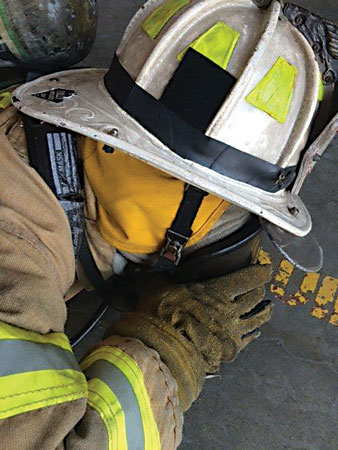 |
| (6, 7) The mask sucks the firefighter’s face, and he immediately drops to the floor and places the mask as close to the ground as possible. He must crack the seal of the mask under his chin just enough to let some air in and then replace it as he exhales. Using the neck strap of the coat, he should tuck his face down to stay as covered as possible. He can perform this several times until he finds a place of refuge. |
So, what if you run completely out of air in a smoke-filled environment? In training, we reinforce that you never remove your mask, and for good reason: If you still have an air supply, removing your mask is the last thing you should do. We are all human, and we need air to breathe. It is not realistic to think that you won’t rip your mask off when it sucks to your face. Hopefully, you are disciplined enough to keep your mask on and remove the regulator. When a wave of panic rushes over you, your reactions will vary based on several factors. If you are ever in this situation, stay mentally tough, and don’t remove your mask. Immediately drop to the floor and break the seal under your chin, leaving just enough air to take in one breath, then replace the mask to exhale (photos 6, 7). This keeps the flash hood and mask almost fully intact and allows the hood to act as a filter. Continue doing this until you reach an exit or a tenable area. If you remove the regulator and keep the mask on, your face will still be somewhat protected.
 |
| (6, 7) The mask sucks the firefighter’s face, and he immediately drops to the floor and places the mask as close to the ground as possible. He must crack the seal of the mask under his chin just enough to let some air in and then replace it as he exhales. Using the neck strap of the coat, he should tuck his face down to stay as covered as possible. He can perform this several times until he finds a place of refuge. |
Now that you are breathing through an open face piece, get as low as you can and seek any clean air that may be in the room while pulling your flash hood out of your coat just enough to cover the inlet of the mask. Depending on heat conditions, you may even remove your flash hood and use it as a filter to try and block out some of the particulates that may enter your lungs (photo 8). If you are still in a high-heat environment, you can also keep your hood on and pull your coat up off your hips slightly and place your face into the upper opening of your coat; this prevents you from breathing the superheated air.
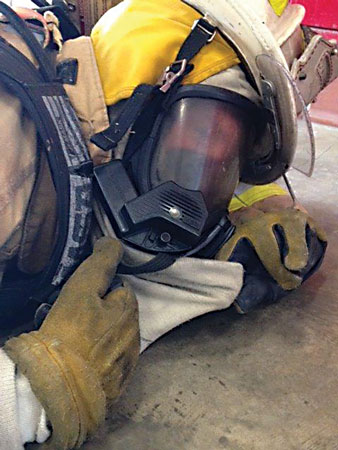 |
| (8) Another option: If the regulator has been removed or damaged, pull your hood out from your coat and cover the opening of the mask to filter out as much smoke and particulates as possible. |
You may say, “Good luck trying to think about doing all of this when the time comes.” This is obviously the worst-case scenario, and none of the options offered in this article are a “silver bullet.” However, if you find yourself in this scenario, your chances of survival are 50/50. Train on your survival methods to ensure they offer the greatest chance of survival if, one day, you have that mask suck to your face and you are forced to react.
Mayday situations are complex, and there are multiple ways to save yourself beyond what I have provided here. Keep the positive mindset that you will be smart and will do what it takes to survive another day. How many times have you conducted Mayday or RIT drills in your firehouse bunkroom? Is this truly realistic training? Practice methods to manage stress under stressful conditions. Perform Mayday drills in places with which you are unfamiliar. Use buildings that are unfamiliar and foreign to you. Place the member playing the down firefighter in uncomfortable situations to increase his stress level. Practice over and over, and you will increase your chances of survival if you are ever in a Mayday situation.
JARROD M. SERGI is a 10-year member of and a lieutenant with Norfolk (VA) Fire-Rescue (NFR) assigned to a ladder company in the city’s first battalion. He is actively involved with local and regional training programs and is an instructor with Real Fire Training, LLC. Sergi has a bachelor’s degree in fire science from Columbia Southern University and is a Fire Engineering blogger.
Firefighter Survival: Training Minutes: Moving a Down Firefighter Up Stairs
Training Program on Down Firefighter Assessment
Rapid Intervention Teams: Saving Their Own
Fire Engineering Archives

